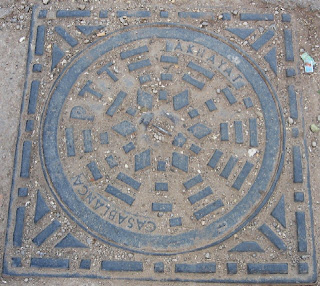Moroccan manholes show the influence of the many years that the country spent as a French "protectorate". Many of the heavy monumental covers reflect the solidity of early designs of foundries such as that at Pont-a-Mousson or the Durenne foundry in Paris. The fact that Arabic script is only rarely present is a further reflection of French influence. Unfortunately the untidy nature of the street scene in the country means that the covers are rarely in good condition and suitable examples for photography are difficult to find.
Casablanca 
Akhayat. Casablanca. Seen in Sefrou
A.Balayer. Casablanca. Seen in Ifrane

Tabors. Casablanca. Seen in Meknes

Fonderie des Tabors. Casablanca. Seen in Ribat-el-Kheir

Tabors. Casablanca. PTT. A telephone cover seen in Rabat

Ville de Fes

Dhis[si F.] du Gharb. Seen in Ifrane. Inscription worn

Fon du Gharb. Seen in Chefchaouen

J Cherel fondeur Kenitra. E Brissard entr. Seen in Kenitra railway station.

Kenitra Meta-Meca. Seen in Chefchaouen and many other towns.

[Kenitra] Meta-Meca. With Arabic inscription. Seen in Rabat.

Ville du Kenitra. Dhissi F du Gharb. Seen in Martil.

Fonderie Vargas, Meknes.

Fonderie Moderne SA Rabat. ONEP. Seen in Moulay Idriss.

Fonderie Nouvelle, Rabat.

Rabat. Probably from Fonderie Nouvelle as it has a similar pattern.

Ville de Rabat, Meta-Meca. See also Kenitra for other Meta Meca examples.

Sale. FPI. Seen in Assilah.

Oulja Sale. Seen in Rabat.

FPI Oulja de Sale Tle 781968. ONPT. Office National de Postes et Telecommunications cover seen in Sefrou.

Assainissement. Sefrou. FPI

Tetuan. Acometida.

Empresa Torres Quevedo. This is an organisation which is loctaed in Tetouan. Seen in Assilah.

Alma assainissement. Seen in Kenitra.

Perhaps an early manhole cover design - there is reputedly a carved drain cover on this Roman site but this may not be the same.
This page last updated 16 Oct 2011.
